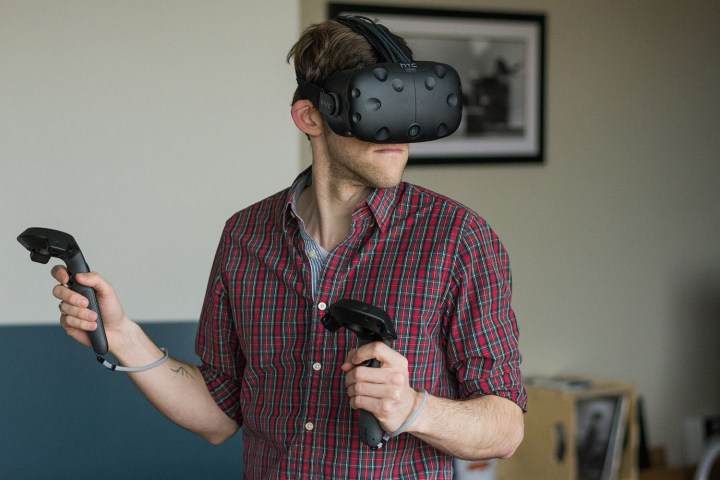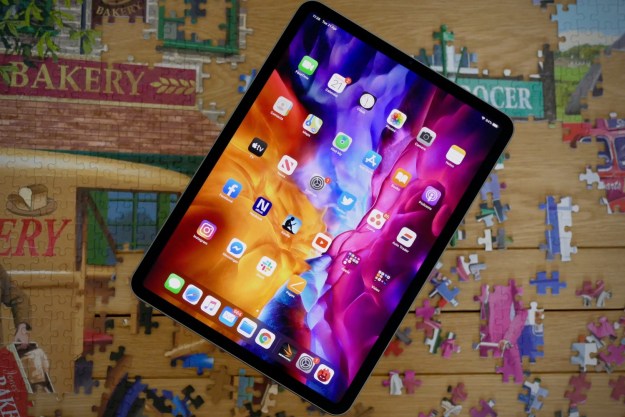
Talk to Oculus VR and HTC and you’ll hear drastically different things. Oculus, with its focus on seated and standing experiences, argues for the idea of artificial locomotion, or using gamepads and controllers to handle your in-game movement — regardless of what founder Palmer Luckey once said. HTC says that real-world movement is the best option for VR, letting people walk around in their roomscale-tracked spaces.
Teaching your brain to accept bizarre movement is part of learning to use VR.
Both solutions have drawbacks. There are immersion issues with artificial movement, and difficulties with nausea in those less experienced. Roomscale VR can dodge those problems, but it requires more space than many people have to dedicate to VR.
To find out where the future of virtual reality locomotion may go, we reached out to developers of hardware and software alike, as well as the extended VR community; we found more controversy than agreement.
The compromised solution
Stress Level Zero was one of the first developers to support the HTC Vive with Hover Junkers, a competitive first-person game. The studio wanted to take advantage of the Vive’s room-scale experience, yet also address the challenges of limited space.
That’s why the studio came up with what developer Alex Knoll describes as the “moving platform” form of virtual reality locomotion. In Hover Junkers, players choose a hovering ship that matches (roughly) their real-world play space in its virtual dimensions, and they can walk around it using Roomscale tracking, as usual.
Moving the ship around the open maps that players fight over is handled with more artificial locomotion, as players connect their in-game tool to the drive-train of their craft and pilot it around one handed.

This blends the two common forms of traversal in virtual reality to allow for comfort and large movement throughout open areas. As anyone who has played the title goes, the idea fits snugly into the game’s world. But careful consideration was taken by StressLevelZero to make the experience of play more comfortable for gamers.
“Filling the users peripheral view with a ‘Frame’ helps quite a bit [with that],” Knoll told me. He also said that making sure ships didn’t rotate was a major step in making the Hover Junkers experience a comfortable one.
Considering it was an HTC Vive launch title, that was a very important consideration for StressLevelZero. The developers knew that a lot of people who would play the game when it came out would be new to virtual reality. It would be pointless to offer a game that was difficult to stomach right off of the bat.
Comfort drives stagnation
Knoll’s focus on player comfort has proven prophetic. Since the release of the first retail headsets, there’s been a rise in use of so-called “comfort movement,” where rotational movement is performed in clunky jumps, rather than smoother movements more typical of first-person perspectives. It’s also seen to a popularization of other types of locomotion in games, like the blink/teleport mechanic which can be seen in games like Vanishing Realms and Call of the Starseed.
Although these methods offer significant improvements to user comfort over artificial movement using a gamepad, it often leads to lazy gameplay. Enemies in Vanishing Realms can be easily defeated if you teleport close, attack, and then teleport out again. It also becomes far faster than exploring naturally in roomscale, so players often ditch “real” movement altogether.
“There are lots of interesting movement mechanics that are built into the core gameplay which are very compelling,” Knoll said, highlighting Budget Cuts and BattleDome, two games that make use of the teleportation mechanic as part of gameplay and the game’s lore, which makes it feel more applicable.
But what type of movement does this movement-blending developer prefer? The most uncomfortable one: artificial movement. To Knoll, teaching your brain to accept bizarre movements in virtual reality is part of learning to use the new platform — much in the same way some people had to get over nausea caused in early first-person 2D games.

“I really like Windlands, as it feels the most freeing,” he said, highlighting a game that has you swinging through trees, canyons, and up mountains, all utilizing artificial movement through the motion controllers.
Then again, Knoll has spent almost as much time in VR as he has out of it over the past couple of years.
“I have a feeling the more people get used to VR the more it will skew towards ‘uncomfortable’ forced movement, as in traditional gaming locomotion methods. Forced positional movement with player body rotational movement seems like it could be the middle ground people lean towards.”
Before stepping into VR, please put this on
Of course, there’s more than one side to the discussion. We also reached out to the guys at Virtuix, the makers of the Omni treadmill, and spoke to CEO Jan Goetgeluk, who sees things differently.
Virtuix opts for an all or nothing approach, suggesting that the only way to experience some game genres is through a motion simulation platform like the Omni.
“There is no substitute for walking and running,” he said, when we asked about artificial locomotion, highlighting the main strength of the Omni — that you can walk and run in VR without running out of room.
What about blinking, or teleportation? When we asked the HTC Vive community on Reddit what their preferred method of locomotion in VR games was, that was the one they picked almost overwhelmingly. But Goetgeluk isn’t a fan.
“Teleportation isn’t what people thought of when they dreamed of VR,” he told Digital Trends. “The last thing they envision is teleporting themselves around the environment. It breaks the immersion and breaks the fun. It’s not a good solution. Developers are not happy with it either. It’s becoming a standard that everybody hates.”
The main idea Goetgeluk champions is physical motion. Whether players walk around their own space or on a treadmill, physically walking around a game world is what he wants to see more of, as it’s the most immersive aspect of virtual reality.
Moving by teleportation isn’t what people thought of when they dreamed of VR.
But while some may see that as meaning games need to be smaller and designed with people’s homes in mind, he sees it as leading to only one solution.
“For VR to be comfortable and safe, you need a motion platform,” he said. “Roomscale is a lot of fun, but it’s still quite limiting, so we truly believe people will need a platform like the Omni to truly experience what VR has to offer.”
This is an interesting point to note about Goetgeluk’s stance. Although he praised what Roomscale is capable of, and is even more impressed with what the likes of The Void can do, he has a fair point in that there will always be space limitations with that sort of technology.
Can they all just get along?
When we asked StressLevelZero’s Knoll what he thought of treadmills, he said they were cool, but not really needed right now.
“I have to focus my thoughts on what comes in the box. We have only just begun to see what’s possible with just a tracked head and controllers, and I imagine it will be a long time before we run out of things to do, without treadmills and harnesses.”
It’s certainly the case that tacking another $500 (or more) on top of the already rather hefty expense of a VR headset and a capable PC isn’t going to sit well with many gamers, even if they feel it’s necessary. And complex harnesses won’t be great for every game. Racing titles, for example, have no need for them.
With clear paths already paved for different modes of movement, we may need to accept there isn’t going to be a one-size-fits-all solution for virtual reality. Some people really enjoy teleportation, others like artificial movement with added roomscale, and there are certainly going to be games and experiences that seem most suited to treadmills and harness systems.
What about the far future?
There is no consensus on locomotion in virtual reality at present, but as people become more used to the idea of moving around a virtual world and their brains becomes accustomed to it, a blend of artificial and roomscale could be the most common.
It offers a blend of open world locomotion on a grand scale, while maintaining the ability to examine things more closely in front of you. That seems to be what the most experienced gamers in our poll decided (we admit, it’s hardly an enormous sample size).

But what about VR in the decades to come? Does Knoll think we’re going to end up in a Matrix-like future, or something akin to Sword Art Online?
“We are so far out from that kind of future that it’s similar to asking ‘wouldn’t it be cool if magic were real?'” he said. “In that sense I think the final holy grail really would be one step further; to download our consciousness into the virtual world and no longer have a need for the physical one.”
For now, he wants to see us move towards something more attainable — wireless headsets, 4K per-eye resolution, and massive increases in field of view.
Perhaps that’s what consumers should demand, too. It certainly would make exploring in VR — in whatever mode proves most popular — easier, more comfortable, and more immersive.
Editors' Recommendations
- Tongue-tracking in VR has arrived
- How this new Quest VR app totally sold me on exercising in virtual reality
- We have some bad news about Apple’s rumored VR headset



